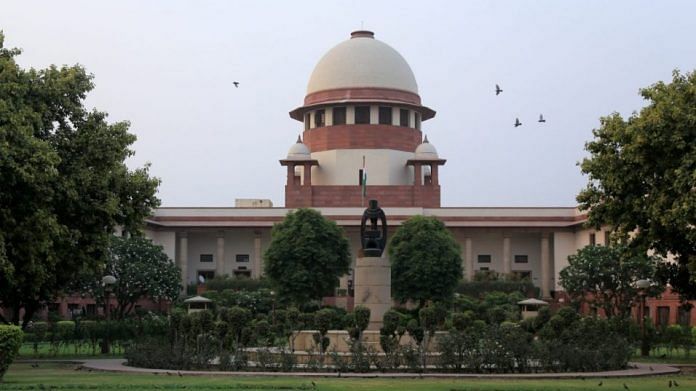New Delhi: The Supreme Court Thursday asked ‘Ram Lalla Virajman’, one of the parties in the politically sensitive Ram Janmabhoomi-Babri Masjid land dispute at Ayodhya, as to how the ‘Janmasthanam’ (birth place of deity) can be regarded as a “juristic person” having stakes as a litigant in the case.
The apex court, hearing the case on the third day, said that so far as Hindu deities are concerned, they have been legally treated as juristic person which can hold properties and institute, defend and intervene in lawsuits.
A five-judge Constitution bench headed by Chief Justice Ranjan Gogoi however asked senior advocate K Parasaran, appearing for ‘Ram Lalla Virajman’ which itself is a party, as to how ‘Janamsthanam’ can file the case in the land dispute as party.
“Whether the birth place can be held to be a juristic or juridical person. So far as idols of deities are concerned, they had been held to be a juristic person,” said the bench, also comprising Justices S A Bobde, D Y Chandrachud, Ashok Bhushan and S A Nazeer.
Responding to the query, Parasaran told the bench, “In Hindu religion, idols are not necessary for a place to be regarded as a holy place of worship…. Rivers and Sun are also worshipped in Hinduism and birth place in itself can be treated as a juristic person.”
The law suit filed by the deity in the Ayodhya case has also made the birth place of Lord Ram as co-petitioner and has sought claim over the entire 2.77 acre of disputed land at Ayodhya where the structure was razed on December 6, 1992.
The bench then referred to a judgement of the Uttarakhand High Court in which the holy river Ganga was held to be a juristic entity entitled to pursue the litigation.
“The Uttarakhand High Court has said that the rivers are also juristic entities capable of being a party in the case,” the bench observed. The bench then asked Parasaran to proceed with his submissions on other issues.
Also read: Supreme Court asks Nirmohi Akhara for proof of possession of disputed Ayodhya site
Parasaran alleged that the deity ‘Ram Lalla Virajaman’ was not made a party when the magistrate had attached the disputed site and when the civil court granted injunction by appointing receiver in the case.
Highlighting the importance of birth place, Parasaran recited a Sanskrit Shloka, ‘Janani janmbhoomis cha swargadapi gariyasi’, and said that a birth place is greater than heaven.
Parasaran also referred to the law on Limitation and said that a “continuing injury” has been caused to the Hindu worshippers by the “continuing wrong” caused by the judicial order by which the property was attached by the magistrate and a receiver was appointed.
“Preventing a person from exercising the right of worship is a continuing wrong and gives rise to continuing cause of action (to avail legal remedies),” the senior lawyer said.
At the fag end of the hearing, the bench said that on December 16, 1949, last ‘namaz’ was offered and asked: “Was it the case that due to placing of the idols, they (Muslims) could not pray”.
Senior Advocate C S Vaidyanathan, appearing for a Hindu party, interjected and said: “No, My lords. They (Muslim) had no access at all.”
After placing of idols there, the character of structure, if any, as mosque got lost, the senior lawyer said.
At the outset, senior advocate Rajeev Dhavan, appearing for a Muslim party, said that the two separate law suits filed by ‘Ram Lalla Virajman’ and ‘Nirmohi Akhara’ respectively are at “loggerheads” with each other and if one is allowed then other goes automatically.
He suggested that the Muslim party can be asked to advance submissions in either of the law suits as only can be allowed legally.
The bench, which would continue hearing the case on Friday, said that it would hear senior advocate Sushil Jain, counsel for Nirmohi Akahara, on the documents in support of its claim over the disputed site.
Fourteen appeals have been filed in the apex court against the 2010 Allahabad High Court judgment, delivered in four civil suits, that the 2.77-acre land in Ayodhya be partitioned equally among the three parties — the Sunni Waqf Board, the Nirmohi Akhara and Ram Lalla.
On December 6, 1992, the Babri Masjid, constructed at the disputed site in the 16th century by Shia Muslim Mir Baqi, was demolished.
Also read: Muslims only offered Friday prayers at Ayodhya site from 1934-49, Nirmohi Akhara tells SC






